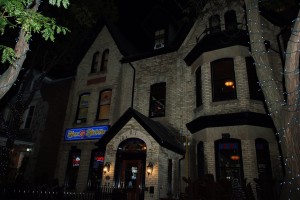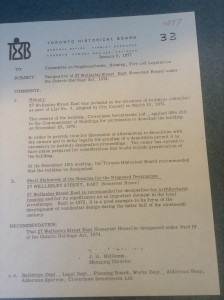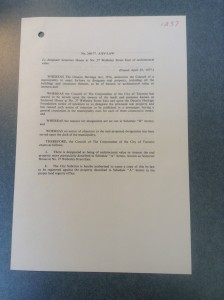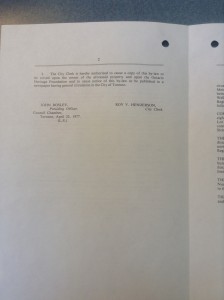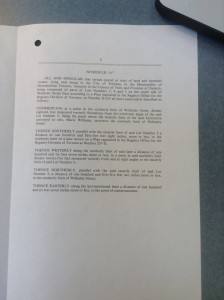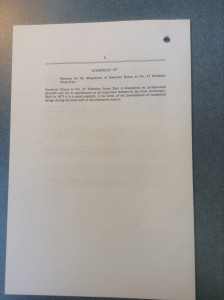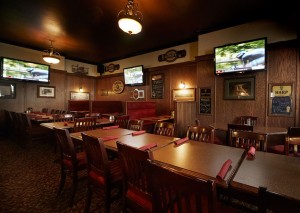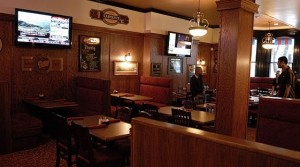The Fox and Fiddle: Karaoke Extravaganza
[Photo credit: wellesleyfox.com]
Fox and Fiddle is the home of Karaoke Extravaganza that is located on 27 Wellesley St E in Toronto, Ontario. The Fox and Fiddle is a pub located in one of Toronto’s historical buildings: Somerset House. This pub holds weekly events for the local community to come out and enjoy. The Karaoke Extravaganza is their biggest event that is held every Thursday, Friday, and Saturday from 10pm to 2am. However, the Fox and Fiddle has not been at this location for long. Interviewee 1 indicated that the pub has only been located in the Somerset House for approximately 5 years.
So what was there before? Through research conducted on the Wellesley location, articles appeared in the Toronto Star that provide evidence to what had been located in the Somerset House before Fox and Fiddle. In January 2007 an advertisement was posted for this location under the business name Fiddler’s Green (Toronto Star “What’s On:Comedy” January 11, 2007). The advertisement was for a stand-up comedy show called Texas Comedy Massacre 2 that would be appearing at the Fiddler’s Green on the following Saturday (“What’s On:Comedy” January 11, 2007). Through the year 2007, 2008, and the beginning of 2009 advertisements where posted for the same pub, Fiddler’s Green, and for the same comedy event. It was not until November 2009 that the advertisements in the Toronto Star changed to the new pub Fox and Fiddle (Toronto Star “Night and day” November 26, 2009). However, the advertisement content remained the same; the comedy show would still be appearing at Fox and Fiddle on Saturday evenings. The advertisements continued to run in the Toronto Star for Fox and Fiddle until January 14, 2010.
Moving further back into history, the historical Somerset House was built in 1873. A document from 1895, published by the Simpson Brothers, indicates that the first owner of the house was a gentlemen by the name of James Cox Aikins (Toronto Public Library “Aikins,James Cox 1823-1904”). At this time the house was called Mapleholme and was original listed as 29 Wellesley St E but was later changed to 27 (Toronto Public Library “Aikins, James Cox 1823-1904”). Following Mr. Aikins, the house was briefly owned by Sir James Pliny Whitney and then J.W.L Forster (Toronto Public Library “Aikins, James Cox 1823-1904”).
Research conducted at the Toronto Archives indicated that the Somerset House was adopted by City Council on March 15, 1974 (Figure 1). The owners of the building at the time were Cloverlawn Investments Limited. On November 23, 1976 Cloverlawn put an application into the Commissioners of Buildings for permission to demolish the Somerset House (Figure 1). However, discussions on alternatives had commenced and the Toronto Historical Board recommended the building be designated. Their statement for Designatation was; “27 Wellesley Street East is recommended for designation for architectural reasons and for its significance as an important element in the local streetscape. Build in 1873; it is a good example in its form of the development of residential design during the latter half of the nineteenth century” (Toronto Archives “Toronto Historical Broad” Figure 1).
The designation by-law, (Figure 2, 2.1, 2.2, 2.3), was passed by City Council on April 25, 1977. The by-law identifies the architectural value of the Somerset House and states that the “Council of The Corporation of the City of Toronto has caused to be served upon the owners of the lands and premises known as Somerset House at No.27 Wellesley Street East…” (Toronto Archives “By-Law 240-77” figure 2).
Advertisements were posted in the Toronto Sun three times during the month of February to bring attention to the Designation of the Somerset House (Figure 3, 4).
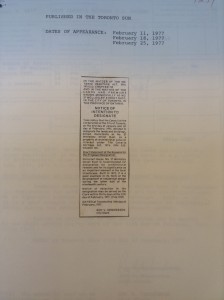
Figure 3: The actual advertisement found in the Toronto Sun during the month of February in 1977. (Document found at Toronto Archives)
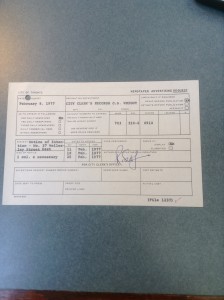
Figure 4: The advertising request form that was put into the Toronto Sun to request the advertisement of the Designation of Somerset House. (Document found at the Toronto Archives)
The most recent document found at the Toronto Archives Center was a letter from 1988 indicating on April 19, 1988 a company by the name of Edgehill Apartments Limited bought the building on Wellesley St E from Ontario Inc (Figure 5).
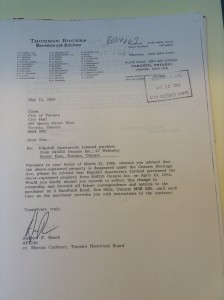
Figure 5: Letter indicating that Edgehill Apartments Limited bought the Somerset House. (Document found at Toronto Archives)
Though there have been many owners of this historical building throughout the years, there has been no connection found to any pervious musical history. However, throughout its history the Somerset House located at 27 Wellesley St E has has held multiple purposes for different owners: a residential home, a business building, and a commercial building.
Analysis
The analysis of Fox and Fiddle will be examined through five concepts discussed by four theorist: Sara Cohen, Raymond Murray Schafer, Jonathan Sterne, and Brandon LaBelle.
The Visual
The structure of Fox and Fiddle is as followed: a three story building with a staircase up the center of the building dividing the house into two sections. The first floor is the pub area that consists of two small rooms on each side of the staircase. The first room is a small room located to the right of the center staircase; this room has no bar and is set up like a lounge/restaurant area. The second room is located to the left of the staircase: this room has an actual bar with high tables and bar stools. The second and third floors of the building are used to hold larger private parties.
The karaoke Extravaganza event is located on the first level of the building in the small room to the right that is set up like a lounge/restaurant. In this room there are five booths located around the outskirts of the room (three against one wall and two against the other). In the middle of the room there are small tables that have been put together to create two larger tables. The karaoke stage is located at the front of the room, in front of the bay window, that looks onto Wellesley St. The karaoke stage consisted of one microphone and a stand. To the left of the karaoke stage stood the DJ with his microphone and equipment.
Surrounding the room was multiple placements of media. There were four television screens: one at the back of the room (directly across from the karaoke stage), two spread out on the left side of the room, and one above the karaoke stage. The placement of the televisions where designed to allow the audience to engage and sing along with the person on stage. The four large lights in the center of the room were off and the little lamps on the walls where dimmed. As well, there was one disco light in the middle of the room that stayed on the entire night. The dimming of lights allowed for the audience to relax and feel more comfortable; while the flashing disco ball set the mood for a fun and exciting night. Also, the music that was playing came from six different speakers that were scattered around the entire room.
The layout, the structuring of furniture and the placement of media plays a very important role in the experience of a place. Sara Cohen in her article Sounding Out The City: Music and the Sensuous Production of Place indicates that “music and place [are] not… fixed and bounded texts or things; but… [rather are] social practices involving relations between people, musical sounds, images, and artifacts, and the material environment” (1 Cohen 276). Cohen quotes emphasis that producing a place/space is more complex than the music; rather it includes all aspects of structuring the physical space as well. The placement of media and the structuring of furniture all contribute to creating a place for an audience to experience. An example of the effects of physical space and the changes in the material environment can be seen through an interview with a young lady, Interviewee 2.
Myself: Have you ever come to Fox and Fiddle before?
Interviewee 2: Yea I have come two times before but it was a long time ago, in 2010.
Myself: Has there been any changes to the pub since you last came here?
Interviewee 2: Oh yea, before there used to be only one TV screen and it was facing the person that was singing. So only the people that where on stage could see the words to the song. And the karaoke stage used to be at the back of the room on this little platform that was supposed to look like a stage. It was hard to see the people who were singing when the stage was at the back of the room.
Myself: Do you feel the changes they have made benefited Fox and Fiddle in anyway?
Interviewee 2: Yea it is so much better, for one the stage being at the front of the room makes it easier to see the people actually singing. And with all the TV screens you are able to sing along with the person singing on stage. It gets everyone involved. It’s very entertaining, kind of like a concert feeling. You sing along and dance in your sit like you do at concerts. I have already caught myself dancing a couple of times. (Interviewee 2 November 23, 2013)
This interview provides an example of how the structure and set up of the place has helped to produce the Karaoke Extravaganza space. The new media and relocating of the stage has allowed for individuals to create a positive experience at Fox and Fiddle. This can be seen in Interviewee 2’s final comment when she indicates that she has already caught herself dancing a couple of times. The connection she made between the physical place and her experience of singing and dancing can be seen as an embodied experience. Cohen reinforces this type of experience by stating that “places can be literally embodied. Through their bodies and bodily movements…people experience their environment physically” (1 Cohen 285). With that being said, the restructuring and changes to the physical environment allowed for the individuals in the audience to enjoy the physical place; which then developes a memoriable experience for them.
The Sound
The idea of Sound will be analysis through two theorist: Raymond Murray Schafer and Jonathan Sterne. This analysis will use Schafer concepts of Soundscapes and Sterne concept of Background Music to analyze the sounds in the Fox and Fiddle’s Karaoke Extravaganza event.
Schafer, in his article Introduction, defines the concept of soundscapes as “any acoustic field of study. [As well, he indicates that] we may speak of a musical composition as a soundscape…” (7). In order to identify the soundscape within Fox and Fiddle this analysis will examine the“sound[s] which are important either because of their individuality, their numerousness or their domination” (Schafer 9). The main sounds that were found in the Fox and Fiddle’s soundscape were laugher, cheering, clapping, singing, and instrumental music. The keynote, a term derived from Schafer’s article, is the instrumental music because it is the reference point in which everything else takes on its special meaning (9). What this means is the reason why you hear singing, laughing, cheering, and clapping is all because of the keynote; and though the instrumental music may get lost through the sounds of the audience, it may become overheard, it can never be overlooked (9). This analysis will now examine instrumental music through Sterne and identify the sounds connection to the experience of place.
Stern’s concept of background music, from his article Sounds like the Mall of America: Programmed Music and The Architectonics of Commercial Space, is identified as “symphonic arrangements of well-known tunes, both contemporary and traditional, that make prolific use of stringed instruments but stay away from brass, voice, and percussion” (Sterne 29). In terms of Fox and Fiddle’s Karaoke Extravaganza, the music that was being played did not have any words. Rather, the music was instrumental pieces of popular music that fell in the background of the performer on stage. Sterne indicates that background music can be “arrangements of popular and traditional songs [and] are thus performed in “a style devoid of surprise” (Radano qtd in Sterne 30). The arrangements of the instrumental music consisted of some songs from Rihanna, Notorious B.I.G, Nirvana, Nickelback, Shakira, and Beyoncé.
Throughout my analysis of sound I found that the audience’s mood would change during the performances depending on the tempo of the song. The more upbeat the song was the more people were out of their seats singing, cheering and dancing. The lower tempo songs had people sitting down, tapping their feet, or singing softly in the background while listening to the performance. Sterne discusses this reaction from the audience through his description of stimulus ratings; “it is clear differences between low and high stimulus ratings are based primarily on rhythm, tempo, and melody. The more upbeat a song, the higher its stimulus rating” (30). Therefore, the connection between sound and experience during the Karaoke Extravaganza event is the fact that together they create a particular experience. The experience of a place is dependent on the tempo of sound that is being delivered.
The Overall Experience
The overall experience will be examined through Sara Cohen’s concept of Ethnography’s and Brandon LaBelle’s discussion on Auditory Latching. I have used Cohen to discuss the overall experience because I feel that the analysis of others experience at Fox and Fiddle is like conducting an ethnography. Ethnography “refers to data derived from direct observation of behavior in a particular society” (2 Cohen 123). In terms of popular music, Cohen indicates that ethnography’s on popular music “focus upon people and their musical practices and processes rather than upon structures, texts or products, [which] illuminates the ways in which music is used and the important role that it plays in everyday life and in society generally” (2 Cohen 127).
Through my observation of popular music in connection to the individuals in the audience, I found that music brought people a sense of security. This is because before the event started people seemed confined to their own groups and their own tables. However, when the event started and the music started to play people became more open and engaged with everything around them. This relates to “auditory latching” that is discussed in LaBelle’s article Pumping Up the Bass- Rhythm, Cars, and Auditory Scaffolding. LaBelle states that DeNora concept of auditory latching is the “act to create a kind of looping whereby embodied presence finds security through percussive” (190) Examples of this are “tapping the ground, drumming the desk, [and] beating one’s own knee….” (LaBelle 190). The sense of security that the music brought to individuals can be seen in two comments from two young ladies who had never been to the Fox and the Fiddle prior to that evening.
Interviewee 3: When I first came in I was overwhelmed, everyone seemed to be regulars or have done karaoke before and I felt kind of nervous being my first time. But after the music started playing and people started singing, I started to really enjoy myself. (Interviewee 3 November 23, 2013)
Interviewee 4: It was a lot of fun, the commentary from the DJ added to the fun experience. I felt really comfortable and wasn’t afraid to sing out loud. It was a really great time. (Interviewee 4 November 23,2013)
Through the music both Interviewee 3 and Interviewee 4 found a sense of comfort and security. The music allowed them to relax and really enjoy their first time at the Fox and Fiddle. In the end, through a direct observation of popular music and the individuals within the environment I found that the music played the role of making people comfortable in their surrounding and allowed them to have an overall great experience.
Closing Remarks
Overall, my personal experience at the Fox and Fiddle Karaoke Extravaganza event was a positive one. Initial I was nervous to attend because I wasn’t sure what to expect. I had never been to a karaoke event before and I wasn’t sure if people would be willing to talk to me about the place. However, I become more relaxed as the night went on. Talking to people became very easy because of the way the mood was set from the lights, the furniture, and the music. I found it very interesting to analyze how people interact and experience this type of an event. I personally really enjoyed myself at the Fox and Fiddle and plan to go back again.
Works Cited
Advertisement in Toronto Sun (Figure 3). Document (1977). Toronto Archives.Fonds 200, Series 822, Subseries 1, File 122. Photo taken December 3, 2013.
1 Cohen, Sara. “Sounding Out the City: Music and Sensuous Production of Place.” Ed. A Leyshon, D Matless, and G Revill. The Place of Music. (1998): 269-290. Course Website. Web. 26 November 2013.
2 Cohen, Sara. “Ethnography and Popular Music Studies.” Popular Music. 12.2 (1993): 123-138. Course Website. Web. 26 November 2013.
1 ibizbook.com. “Photo inside Somerset House.” Photograph. Webshots. Web. 28 November 2013.
2 ibizbook.com. “Photo inside Somerset House.” Photograph. Webshots. Web. 28 November 2013.
Interviewee 1. Personal Interview. 23 November 2013.
Interviewee 2. Personal Interview. 23 November 2013.
Interview 3. Personal Interview. 23 November 2013.
Interview 4. Personal Interview. 23 November 2013.
LaBelle, Brandon. “ Pump Up the Bass- Rhythm, Cars, and Auditory Scaffolding.” The Senses and Society. 3.2 (2008): 187-203. Course Website. Web. 25 November 2013.
Letter of Purchasing of Land (Figure 5). Document (1977). Toronto Archives. Fonds 200, Series 822, Subseries 1, File 122. Photo taken December 3, 2013.
Newspaper Adverising Request (Figure 4). Document (1977). Toronto Archives. Fonds 200, Series 822, Subseries 1, File 122. Photo taken December 3, 2013.
No. 240-77. A By-Law (Figure 2). Document (1977). Toronto Archives. Fonds 200, Series 822, Subseries 1, File 122. Photo taken December 3, 2013.
No. 240-77. A By-Law (Figure 2.1). Document (1977). Toronto Archives. Fonds 200, Series 822, Subseries 1, File 122. Photo taken December 3, 2013.
No. 240-77. A By-Law (Figure 2.2). Document (1977). Toronto Archives. Fonds 200, Series 822, Subseries 1, File 122. Photo taken December 3, 2013.
No. 240-77. A By-Law (Figure 2.3). Document (1977). Toronto Archives. Fonds 200, Series 822, Subseries 1, File 122. Photo taken December 3, 2013.
Schafer, Raymond M. “Introduction.” Soundscape : 3-12. Course Website. Web. 25 November 2013.
Sterne, Jonathan. “Sounds like the Mall of America: Programmed Music and the Architectonics of Commercial Space.” Ethnomusicology. 41.1 (1997): 22-50. Course Website. Web 26 November, 2013.
Toronto Historical Board (Figure 1). Document (1977). Toronto Archives. Fonds 200, Series 822, Subseries 1, File 122. Photo taken December 3, 2013.
Toronto Public Library. “ Aikins, James Cox, 1823-1904; with his wife Mary Elizabeth (Somerset).” Simpson Brothers. (1895). Web. 20 November 2013.
Toronto Star. “ What’s On: Comedy.” Entertainment. 11 January 2007. Web. 22 November 2013.
Toronto Star. “ Night and day.” Entertainment. 26 November 2009. Web. 22 November 2013.
Wellesleyfox.com. “Picture of the Somerset House.” Photograph. Webshots. Web. 28 November 2013.
